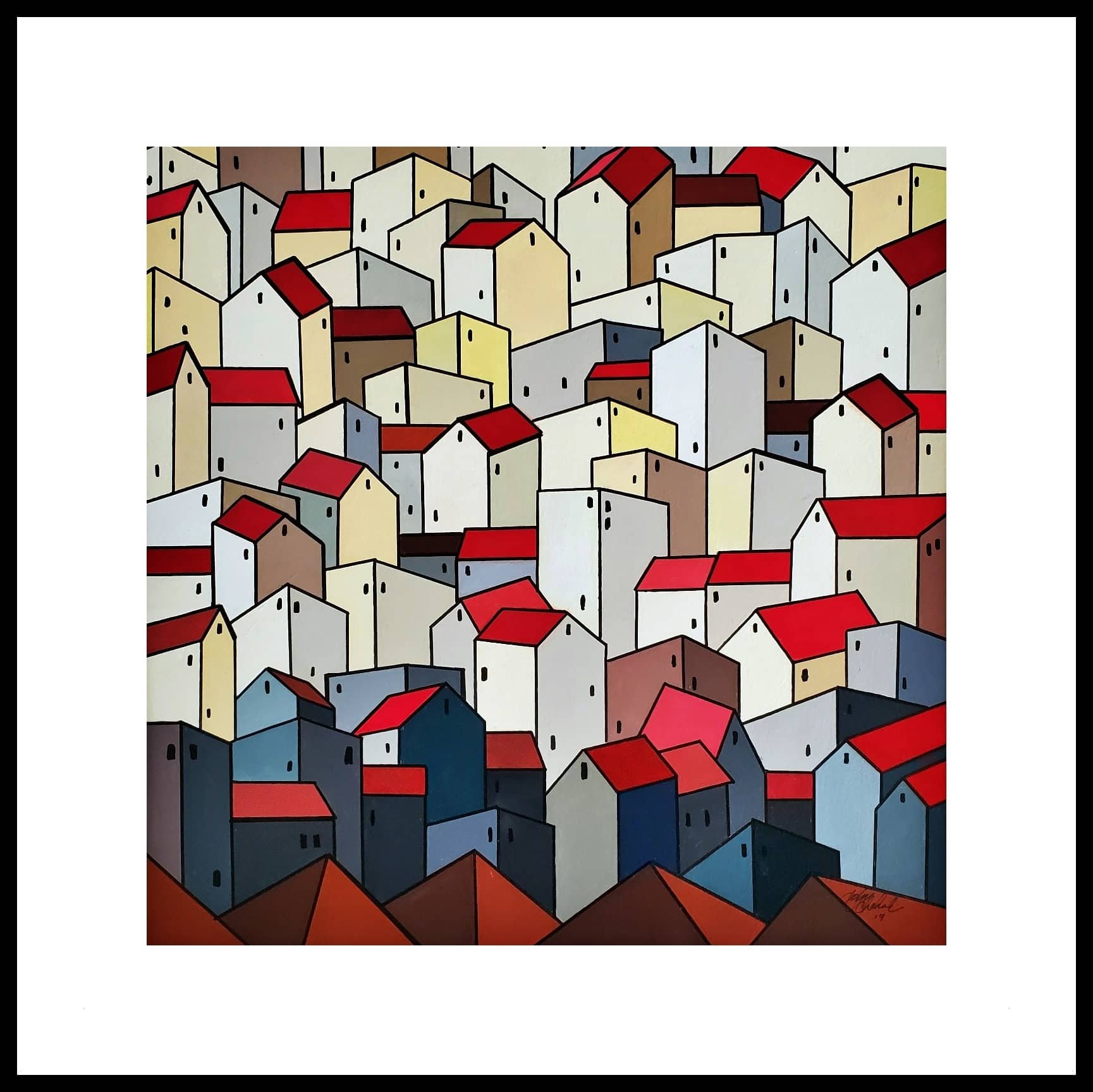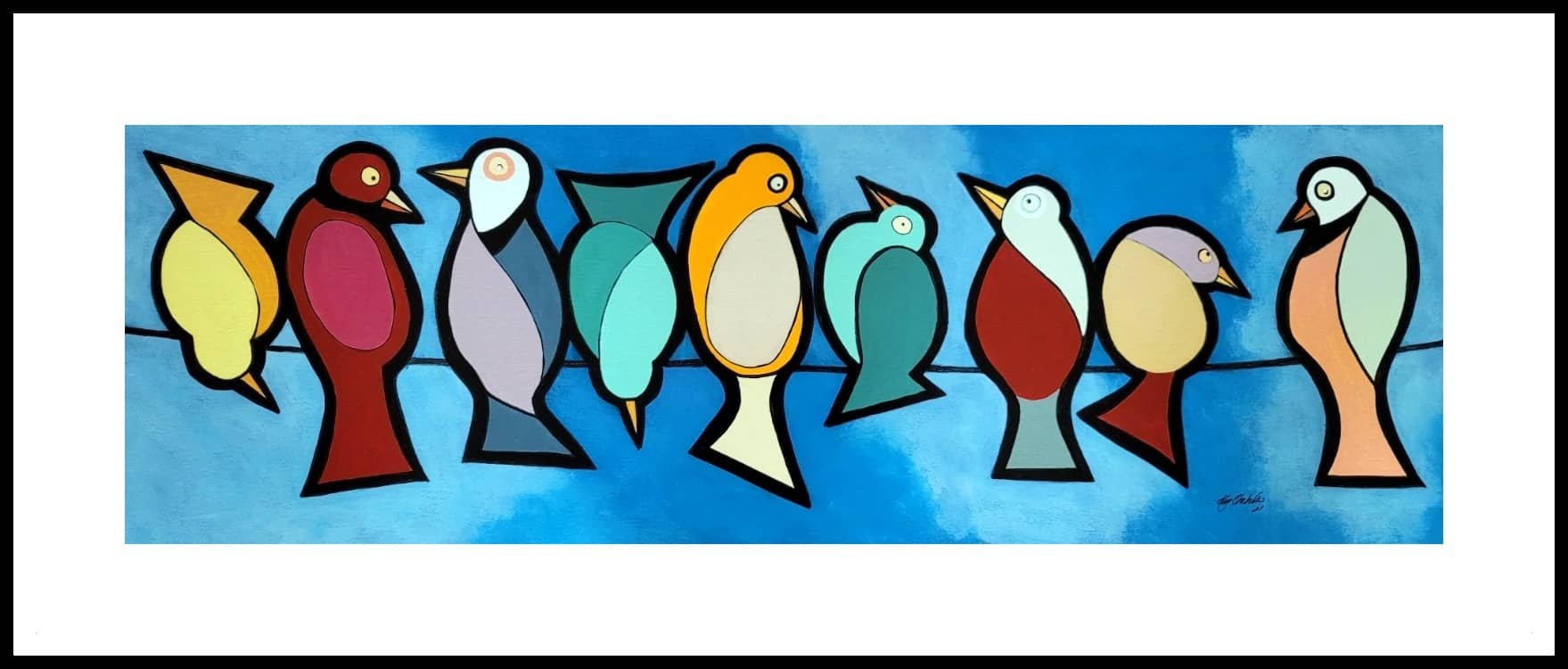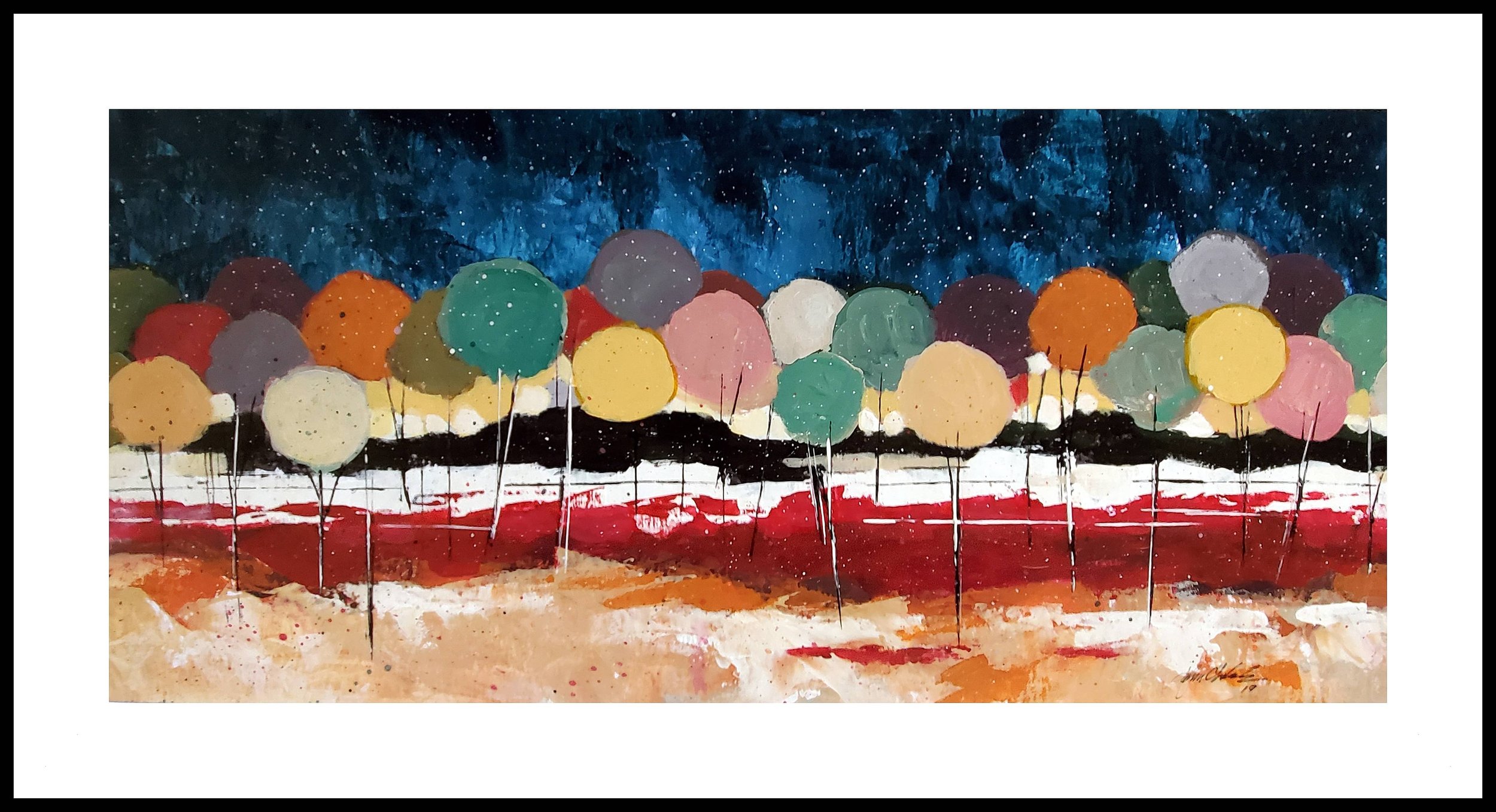John Chehak: An Acrylic, Cubist Painter
Congratulations to John Chehak for earning his place as a Winner in the Boynes Monthly Art Award [October Edition]!
Who are you?
I was born and raised in Cedar Rapids, Iowa. As a child I enjoyed drawing and painting, but art was just something nice to look at. I took for granted that anyone could paint or draw, and it was just a casual doodling hobby for me. I graduated from the University of Iowa College of Pharmacy in 1973 and began practicing retail pharmacy in my hometown. In the early 80's I stopped practicing pharmacy to pursue other healthcare related business ventures including computer software development, hospital marketing, and home health care management. By the time I was in my late forties I noticed that my friends were playing too much golf, buying fast cars, taking cooking classes, or skiing in the mountains. I began to feel an urge to explore my long dormant artistic abilities. I really don’t know why. Call it my mid-life crisis.
“10 On A Wire”
Acrylic on Paper Matted & Framed
By John Chehak
When I actually decided to pick up a brush, I knew I wanted to use paint that would dry quickly, not oil based, was water soluble - but not watercolors, and did not smell. My medium of choice was, and still is, undiluted acrylic paint on paper and canvas. I purchased the necessary supplies: paint, brushes, a few canvases, and heavy watercolor paper and created a space in my home to paint. I quickly realized that I preferred to paint on 140-pound archival watercolor paper and a fixed size (36”x36”x2.5”) canvas.
“Village Reflection”
Acrylic on Paper Matted & Framed
By John Chehak
As I started to collect a rather large portfolio of artwork, I needed to figure out how to promote my work and eventually sell my paintings. After participating in a couple of local art shows and doing some research I decided to apply to a number of regional art fairs within two hundred and fifty miles from my home. Shows that were scheduled from May until September were the only ones I wanted to consider. My only motivation was to see if the public was interested in purchasing my work so I could generate more funds to buy more supplies so I could paint more pictures. As I began to get accepted in many juried fairs for which I had applied, I realized I had opened another “can of worms.” Besides paying the substantial fees for most juried events, I needed to purchase a good quality tent and add some amenities to it like a comfortable flooring, a decorative rug, lighting to highlight the work, and good quality display panels for hanging my art. Other expenses included reserving hotel rooms, food and gas purchases, securing programs that allowed me to accept credit cards on my phone, and whether to purchase a van or rent one for transportation. If that wasn’t enough, I needed to standardize a mat and framing plan for my paintings and finally, price my work. I’m sorry but I have to take a short break now. I'm exhausted just thinking about how much work was involved and the large expense I had to invest, not to mention convincing my wife to go with me to the shows. As of this writing we have participated in more than seventy-five juried art shows and I have sold more than six hundred original paintings. My matted and framed paintings range from three-hundred dollars to a little more than one-thousand-two-hundred dollars. My average sale price is about four-hundred-seventy-five dollars U.S.
“A Bumper Crop”
Acrylic on Paper Matted & Framed
By John Chehak
My style has developed from the need to “un-trap myself” from an artistic routine and to explore other expressive and creative opportunities. Twenty-three years later, my work has come full circle. It was once described on the Des Moines based Kavanaugh Gallery's website: 'His muted colors and distinct choice of subject matter have attracted collectors throughout the nation. Many of Chehak's paintings emerge directly from his imagination.' My subjects have included urban scenes in New York, Chicago, St. Louis and New Orleans, but I still prefer the sedate, yet captivating, landscapes of the Midwest. Rural compositions of rolling hills, farmlands, red barns, and the like characterize my earliest unique style. I'm particularly fond of the symmetry and beauty of buildings and other structures, both urban and rural. In recent years my work has taken on new and unique personalities with more vibrant colors, symmetry, and compelling presentation. I now have patrons in more than 40 states.
A few years ago, an online reviewer wrote, “Native Iowan John Chehak is a masterful draftsman and painter…His wide expanse of expertise and style make his artwork a treat to explore.” Regardless of description, I still strive to create original work in style, color, and subject matter. For the past thirteen years my wife and I have participated in exclusive juried art fairs in Chicago, Marion Ia, Evanston, Minneapolis, Edina Mn, Omaha, Hinsdale, Il Elmhurst Il, Winnetka Il, Geneva Il, Wheaton Il, Oconomowoc Wi, St. Charles Il, Peoria Il, Northbrook Il, St. Louis Mo, and Madison Wi.
“A Distant Reflection”
Acrylic on Paper Matted & Framed
By John Chehak
WHAT INSPIRED YOU TO UTILIZE PAINTING AS A MEDIUM?
I guess my immediate inspiration was to see if someone else enjoyed my art. Even more inspirational is when someone actually purchased a painting. It was a validation of my work. I was also inspired by the hundreds of artists I met and admired at the shows.
“Urban Crowding”
Acrylic on Paper Matted & Framed
By John Chehak
How would you describe your ARTwork?
Fun, unique subject matter, bright colors, affordable, just the right size. After a while I noticed that my artwork could be categorized into six unique subsets: Contemporary, Reflection Series, Urban Crowding, Landscapes, Architecture, and My Birds. There is a gallery page on my website that shows general examples of my work. Contemporary is my catch-all category for paintings that don’t easily fit into one of the other categories.
“Fishing Hole”
Acrylic on Paper Matted & Framed
By John Chehak
CAN YOU WALK US THROUGH THE TECHNICAL STEPS OF CREATING YOUR WINNING WORK?
I do not use a regular easel. I lay the canvas onto a 4-foot by 8-foot wooden homemade fixture that sits at about a 30-degree angle. Same for the paper substrate except I tape it onto the board. My favorite work is on 140lb paper using undiluted acrylic paint. Also, I found that using an acrylic clear coat on top of my paintings not only makes the colors pop, but it also protects it, especially from sunlight. I experiment with hot air sources (blow dryer or even a paint stripper) to quickly dry the paint as needed. This allows me to apply layers of paint quickly and I admit it took a little practice with the paint stripper which obviously generates very high heat. I finally use a backing board, mat board, a lightweight acrylic (plastic) cover and frame the results. I use the same simple black frame on all my pieces to not complicate the presentation with loud and different frame styles that detract from the painting. The end result is a uniform high-quality presentation at juried art fairs in the Midwest.
“Town Reflection”
Acrylic on Paper Matted & Framed
By John Chehak
What do you hope to communicate to an audience with your work?
A happy emotion, a smile, a discussion about my work and an affordable way to take my original work home.
“Nine On A Wire”
Acrylic on Paper Matted & Framed
By John Chehak
Can you talk about your biggest learning experience during the process of creating your work?
For me, when doing shows and fairs I have to remember that for every one hundred people that walk by only a handful or so will actually stop in and look at my art. I can analyze this two ways: 85-90% of the people don’t like my art or are at the show to simply exercise their dog OR remind myself that 10-15% of the people are interested. Remember that these people liked your work enough to consider buying. I give each one of them my fullest attention. I don’t sit down and let them look freely. To me that’s ignoring them. They want to talk to me. I acknowledge them and ask if they would like to hear the story about the artwork they are looking at.
“Organizing The Sing Along”
Acrylic on Paper Matted & Framed
By John Chehak
Can you discuss your biggest success since starting your artistic journey?
Easy. At the 2018 St Louis Art Fair in Clayton, Missouri I attended the show with close to forty paintings. I went home with two. I had to cancel a couple of shows scheduled for the next month due to lack of inventory.
“Lunch At Water’s Edge”
Acrylic on Paper Matted & Framed
By John Chehak
Can you give us a piece of advice you wish you had known at the start of your career?
I used to be a perfectionist. But I have changed, and I am no longer overly critical of my work. We all have different likes and dislikes in the world of art. Like I mentioned before,when I’m selling at art fairs, for every 100 people that walk by my booth about 10-15 will actually come in and look. That’s an incredible 10-15 percent of the daily attendees like my art. Whether it’s 2,000 or 20,000 people that pass through a show in a weekend, the possibilities add up. But I have to communicate and in some cases negotiate with them.
“Outside Looking In”
Acrylic on Paper Matted & Framed
By John Chehak
What projects are you working on currently? Can you discuss them?
I have recently finished a few pieces and have included examples.
“The Grove”
Acrylic on Canvas
By John Chehak
What is your dream project or piece you hope to accomplish?
I would be honored to be represented in my hometown Museum of Art. The same museum contains many pieces of art by artists I am familiar with, I personally knew and currently know.
“Stop At the House With Red Top On The Way Back”
Acrylic on Paper Matted & Framed
By John Chehak
As a winner, do you have any advice for artists who want to submit to awards, competitions, residencies, etc.?
Be confident in yourself. If you can attend a show nearby, do so and talk to the artists. Be prepared to commit to the expense of purchasing products necessary to present yourself as a serious artist. Buy the best you can. Your first impression to the public is the one they remember.
“The Forest At Night”
Acrylic on Paper Matted & Framed
By John Chehak
Lastly, I like to ask everyone what advice they would give to their fellow artists, what is your advice?
It’s so easy or should I say comfortable to stay within your own boundaries of subject matter, technique, type of medium, and color choices. But I suggest you experiment with color palette, subject matter and technique. You will discover a whole new way of understanding your process. I still find it difficult to use lime green color. Unfortunately, I’m getting older now and realize I have lost some of the desire to change my comfort limits. However, painting is not the kind of “job” you can ever retire from easily.
To view more of John Chehak













